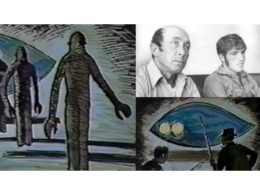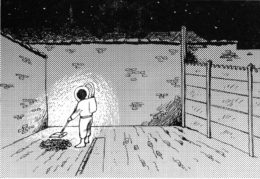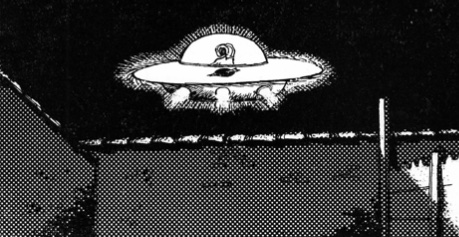by Charles Lear
 In 1973, there was a worldwide wave of UFO associated humanoid encounters. Arguably, the most famous of these was the alleged abduction in Pascagoula, Mississippi, of Charles Hickson and Calvin Parker. They reported being forcibly taken aboard a craft by three, approximately five-foot-tall, robot-like, elephant-skinned creatures with crab claw-like hands, no eyes, a slit for a mouth and cone-shaped protrusions where the nose and ears would be on an earthly creature. While the creatures described by Hickson and Parker are unique in UFO literature, what is common to the 1973 humanoid wave is that most of the creatures described were unique. One report that stands out came from the city of Vilvoorde in Belgium. It was investigated by the Societé Belge d’Etude des Phénomènes Spatiaux, and an article describing the reported encounter written by Jean-Luc Vertongen appears in the SOBEPS journal, Inforespace No. 18, 1974. It was translated by Gordon Creighton and included in Flying Saucer Review, Vol. 20, No. 6.
In 1973, there was a worldwide wave of UFO associated humanoid encounters. Arguably, the most famous of these was the alleged abduction in Pascagoula, Mississippi, of Charles Hickson and Calvin Parker. They reported being forcibly taken aboard a craft by three, approximately five-foot-tall, robot-like, elephant-skinned creatures with crab claw-like hands, no eyes, a slit for a mouth and cone-shaped protrusions where the nose and ears would be on an earthly creature. While the creatures described by Hickson and Parker are unique in UFO literature, what is common to the 1973 humanoid wave is that most of the creatures described were unique. One report that stands out came from the city of Vilvoorde in Belgium. It was investigated by the Societé Belge d’Etude des Phénomènes Spatiaux, and an article describing the reported encounter written by Jean-Luc Vertongen appears in the SOBEPS journal, Inforespace No. 18, 1974. It was translated by Gordon Creighton and included in Flying Saucer Review, Vol. 20, No. 6.
According to the article, at around 2:00 a.m. one morning in mid-December 1973, a Mr. “V. M.” was moving through his darkened house using a flashlight so as not to wake his sleeping wife. He was headed towards the toilet in the yard next to his kitchen when he noticed a noise like a shovel hitting the ground and saw a green glow on the edge of one of the kitchen window curtains.
 The witness went to the window, opened the curtains, and saw a creature in front of the wall on the other side of the yard. According to the witness’s description, the creature had a green glow about it from head to foot and was a little over one meter tall. It was wearing what looked like a space suit, and was waving a device that looked like a vacuum cleaner or metal detector over some brick pieces that the witness had piled up earlier. The glow came from the creature’s suit, which the witness described as looking like the metallic tinged polyester used for the upholstery on “buggy” type vehicles.
The witness went to the window, opened the curtains, and saw a creature in front of the wall on the other side of the yard. According to the witness’s description, the creature had a green glow about it from head to foot and was a little over one meter tall. It was wearing what looked like a space suit, and was waving a device that looked like a vacuum cleaner or metal detector over some brick pieces that the witness had piled up earlier. The glow came from the creature’s suit, which the witness described as looking like the metallic tinged polyester used for the upholstery on “buggy” type vehicles.
 The creature was wearing a transparent helmet that had a tube going down into a unit on the creature’s back, which was towards the witness. The color of the tube and unit matched that of the uniform. The witness noticed a belt, also the same color, around the creature’s waist. The 3 or 4 cm wide belt seemed to be supporting an 8cm long by 3 or 4 cm wide red box on the creature’s abdomen. The box emitted a steady red light.
The creature was wearing a transparent helmet that had a tube going down into a unit on the creature’s back, which was towards the witness. The color of the tube and unit matched that of the uniform. The witness noticed a belt, also the same color, around the creature’s waist. The 3 or 4 cm wide belt seemed to be supporting an 8cm long by 3 or 4 cm wide red box on the creature’s abdomen. The box emitted a steady red light.
The creature’s pants were slightly puffed out and tucked into boots as were its sleeves, which were tucked into the gloves on its five-fingered hands. The creature’s head appeared round and black and the witness assumed it was covered with short hair. The creature made no sound and the witness couldn’t detect any respiratory movement.
The creature moved with a slow waddle and only bent its knees slightly. The witness flashed his flashlight twice and the creature turned around. Its face was dark and the witness could see no mouth or nose, but he did see eyes and slightly pointed ears. The eyes were large, oval-shaped, yellow with a green rim around them, and the witness described seeing black and red veinlets around the iris. Periodically, membranes (described in the article as being vertical versions of the horizontal membranes of cats’ eyes) came down over the eyes, and the face became completely dark.
 The creature raised its right hand and made a “V” with its index and second finger. It then turned and walked towards the wall. It placed one foot on the wall, brought up its other foot and then, with a stiff-legged gait, proceeded to walk straight up the wall. It arced over the top and presumably walked down the other side of the wall in a similar fashion.
The creature raised its right hand and made a “V” with its index and second finger. It then turned and walked towards the wall. It placed one foot on the wall, brought up its other foot and then, with a stiff-legged gait, proceeded to walk straight up the wall. It arced over the top and presumably walked down the other side of the wall in a similar fashion.
Then a white glow appeared on the other side of the wall along with a sound like that made by crickets. A craft rose up slowly that the witness described as being about five meters in diameter and saucer-shaped. The upper part was phosphorescent orange and the lower part was dark claret-colored. The creature could be seen in a cupola on top that emitted a green glow and there were three lights along the bottom. The light on the left (witness view) was blue, the middle one was yellow and the right one was red. Directly below the cupola there was an emblem described as a black circle with a diagonal lightning bolt. The witness described seeing sparks like those from a cigarette lighter around the edges of the craft.
 The craft rose up to 20 meters and then rocked gently back and forth with a shower of sparks. The cricket-like sound grew louder, turned into a hiss, and then the craft accelerated and shot up, leaving a luminescent trail.
The craft rose up to 20 meters and then rocked gently back and forth with a shower of sparks. The cricket-like sound grew louder, turned into a hiss, and then the craft accelerated and shot up, leaving a luminescent trail.
According to the witness, he felt no fear during the entire encounter. In fact, he reported that he fixed himself a snack, sat down in the kitchen and ate it, and then went to bed and slept peacefully.
The SOBEPS investigators got to the site in March 1974. They found no physical evidence and were unable to locate other witnesses, despite the fact that the wall separated the house of the witness from a convent. In addition, the investigators stuck 500 letters in mailboxes around the area asking if anyone had seen anything unusual on the morning in question, and no one responded.
The witness told the investigators that he’d had a sighting with his cousin and sister-in-law prior to this one. On that occasion they saw a flat, red rectangle over the ocean. When the investigators revisited him in July 1974, he said he’d been driving with his wife and cousin when they saw what looked like a second moon. As they were observing it, his car stalled and the lights went out. The “moon” moved off and the car restarted.
With a single witness case, investigators usually do what they can to establish the credibility of the witness. In this case, the SOBEPS investigators questioned the detailed description given by the witness, particularly that of the veinlets in the eyes. To test the likelihood that he could actually see that much detail at that distance, they had the witness make a full-scale drawing of one of the eyes. They observed it at the reported distance of about 10 meters and confirmed that it was possible to see such detail provided there was sufficient light, which would have been likely with a self-luminescent creature.
They also looked into whether the witness had a prior interest in UFOs. The witness said his interests were in early history and vanished civilizations and that he had no particular interest in UFOs. It is noted the that witness had read Frank Edwards’s book, Flying Saucers, Serious Business, but it is emphasized that this was after his sighting. Vertongen reports that SOBEPS investigators rated the case according to the Poher Scale and gave it a credibility rating of 3 and a strangeness rating of 5.